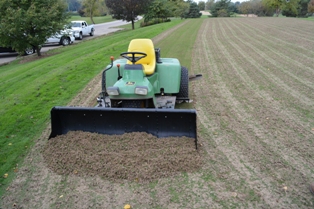We have a variety of athletic fields including native soil fields, sand-based fields, and some that have been sand topdressed over native soil for several years. I have started using some wetting agents to help manage dry spots and we are experiencing some benefits. I’m hearing about using them to improve drainage also. How can this be and could you explain how a wetting agent can help when it is too dry and too wet?
Joe Wagner, Iowa City Parks and Recreation
I can usually shoot from the hip on most of my sports turf topics but I’m glad I took the time to research Mr. Wagner’s question because newer products have been developed with specific benefits to manage water. The late USGA agronomist Stan Zontek put together a comprehensive review article on wetting agents in 2012 that is really helpful and applies for sports turf managers. In general wetting agents are compounds that help water to spread across or penetrate into the surface of a solid by reducing the surface tension (surfactant) of the water. Soap is a common wetting agent that acts as a surfactant to reduce the surface tension of water allowing it to easily disperse and spread as we wash our hands.
First, ask yourself am I dealing with an anionic or non-anionic wetting agent? Anionic wetting agents have a negative charge and can cause dispersion of clay particles that negatively impacts fine-textured native soils by allowing them to pack tighter. This older type of chemistry was developed in the 1950’s and commercially available blends are available as AquaAid, Naiad, Penterra, and Prevade.
Nonionic surfactants can be broken down into two general groups. Those also developed in the 1950’s POE—Polyoxyethylene (some examples include E-ZWet, FloThru, Injector, PenMaxx, Surfcide, Wet-Sol, LescoWet), and a newer group of nonionic compounds developed in the 1990’s called block co-polymer compounds. The anionic and nonionic products developed in the 1950’s were developed to remedy localized dry spot but they were subject to phytotoxicity depending on the application rate and turfgrass species.
Block co-polymer surfactants are the most commonly used class of wetting agents applied today. They are safer to use on fine turf, reduce water repellency of soil and thatch, and have the unique feature of improving soil water content and plant-available water. Two categories exist in block co-polymer technology. Straight block co-polymers that enhance water movement in the soil and can be helpful in leaching programs include: Brilliance, Capacity, Cascade Plus, Conduit 90, Hydro-Wet, LescoFlo Ultra, Remain, and Sixteen90. Reverse block co-polymers enhance moisture retention in chronically dry soils and are sometimes called “retention-type surfactants.” Introduced in 1995 they include: Primer Select, Magnus, ReLoad, Rely II, Respond 3, Retain, TriCure AD, and TriCure Micro.
Blends of the “straight and reverse” block co-polymers have been developed to capture the best of both worlds; correct dry spots and enhance water movement. Commercially available products include Aqueduct, Resurge, and ReWet. Turf managers are always trying to field mix wetting agent/soil surfactant products to achieve rewetting, moisture retention, and moving excess water through the soil profile and this is what leads directly to answer Joe’s question. Yes, the technology of wetting agents has advanced in such a way that blended or mixed products use similar water tension forces to reduce hydrophobicity (water repelling) and dry spots while at the same time allowing for better water penetration and movement through soils.
Alkyl Polyglucoside surfactants are another category of water managing products that uses a sugar molecule reacted with a fatty acid to reduce water repellency. Their claim to fame targets improved water availability and enhanced irrigation efficiency. Mixed with straight block co-polymers these products are available as Dispatch Injectable and Sprayable, TournamentReady.
Just when you thought it was safe to come out, here is another twist on these designer compounds. By replacing -OH groups with –CH3 it creates thinner films of water that attach to the soil particle in a way that keeps it from completely drying out. The film of water allows for faster rewetting and quick penetration into the ground. Obviously this helps with dry spot, but it also helps by reducing puddles from a brief shower. This modified methyl capped block co-polymer is commercially available as Revolution.
Okay, I don’t want to know any more about wetting agents. After researching it I know the newer products won’t burn my grass, will allow water to penetrate the soil faster, and may improve turf quality through preventing extremely dry or wet conditions. I’m gonna give it a shot but I will keep in mind that while these rather chic components do help manage water they do not turn a slow draining puddly native soil situation into a rapid draining sand base system; it does not make your drainage go from less than an inch an hour to more than 6 inches per hour. They are not substitutions for proper soil mixtures, drainage, and irrigation systems. Using the right combination of wetting agents/surfactants can help you reduce dry spot, use water more efficiently, and at the same time remove excess water from the surface of a playing field. These are all good reasons to try a wetting agent on fields that are too often too wet or too dry.


